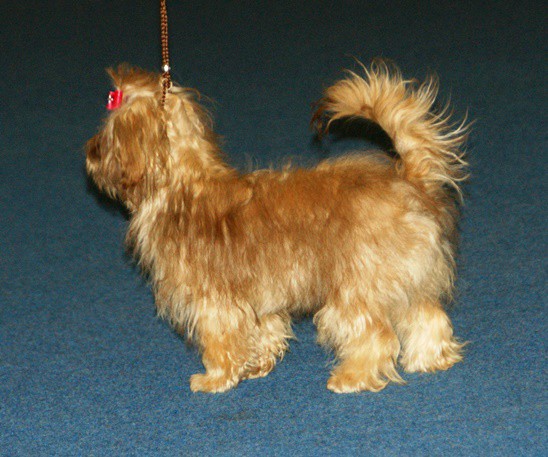Type the name of the breed you're looking for below
[wpdreams_ajaxsearchlite] Don't see the breed your're looking for? Click here and let us know!
Breed Characteristics
1 paw - breed exhibits the least amount of this characteristic
5 paws - breed exhibits most amount of this characteristic
Russian Tsvetnaya Bolonka
| Other Names | Russian Bolonka, Bolonka-Zwetna, Russkaya Tsvetnaya Bolonka, Russian Coloured Bichon |
| Country of Origin | Russia |
| Weight | 8 - 10 lbs. (3.5 - 4.5 kg) |
| Height (at withers) | 7 - 10 in. (17 - 25 cm) |
| Coat | Double coat with dense, thick, silky, soft outercoat forming waves or large curls and well-developed undercoat; beard and mustache. |
| Colour | It is accepted in all colours except white; no more than 20% white is accepted. |
| Litter Size | 1 - 3 puppies, average 2 |
| Life Span | 10 – 17 years |
| Origin & History | The first dogs were, according to Romanenkova, depressing in appearance as efforts to develop coat, as well as effective coat care, had to deal with he scarcity of water and fine shampoos and conditioners used in the west. For example , harsh homemade laundry soaps with lye as its base were first used to wash the dogs with a rapid and devastating drying of the coat. Another example is reflected in the colour of the Tsvetnaya Bolonka. While there is now a rainbow of colours, the black remains the dominant colour having been specifically bred into the breed in order to accommodate the scarcity of water and shampoo for washing a long coated dog. Similarity the tear drainage seen in dogs is less noticeable in a black or dark dog than a white dog. The mats that more often than not accompany longer coated breeds could not be readily detangled in the Former Soviet Union therefore breeding programs encouraged the development of the silky looping curls which have a soft and downy undercoat possessing soil-repellant qualities that also decreases the incidence of matting. |
| Personality | Bolonki are sturdy, happy, playful little dogs with an affectionate and loving temperament that is ideal for their role in life. They are intelligent, outgoing, trusting and energetic dogs that will also be content to sit quietly on a lap for as long as it is allowed. They need gentle, firm obedience training. Make sure you are this dog's firm, confident, consistent pack leader to avoid Small Dog Syndrome, human induced behavior problems. Always remember, dogs are canines, not humans. Be sure to meet their natural instincts as animals. |
Care Requirements
| Health | This breed is prone to typical small-dog health conditions, including: luxating patella, hip dysplasia, liver shunt, thyroid, heart, eyes. Because of the rarity of the breed this information is not fully documented; however, ethical breeders and owners are asked to health test and submit these results to the OFA and breed health databases. |
| Grooming | Regular grooming is necessary. Comb a few times a week and bathe as needed. Shampoo, condition, towel dry until damp then comb with a wide-tooth comb or pick. Minimal blow drying so their characteristic curls form. Hair can be kept off of the eyes with bow or band. |
| Exercise | These little dogs, need a daily walk. Play will take care of a lot of their exercise needs, however, as with all breeds, play will not fulfill their primal instinct to walk. Dogs that do not get to go on daily walks are more likely to display behavior problems. They will also enjoy a good romp in a safe, open area off lead, such as a large, fenced-in yard. |
| Other Considerations | Bolonki are suitable for people in towns and cities as well as in the country. They are active indoors and will do okay without a yard. |



